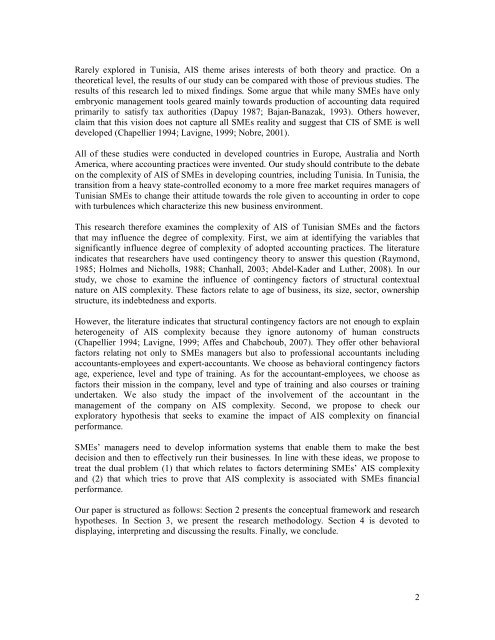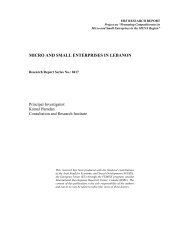Accounting Information System of Tunisian SMEs - Economic ...
Accounting Information System of Tunisian SMEs - Economic ...
Accounting Information System of Tunisian SMEs - Economic ...
You also want an ePaper? Increase the reach of your titles
YUMPU automatically turns print PDFs into web optimized ePapers that Google loves.
Rarely explored in Tunisia, AIS theme arises interests <strong>of</strong> both theory and practice. On atheoretical level, the results <strong>of</strong> our study can be compared with those <strong>of</strong> previous studies. Theresults <strong>of</strong> this research led to mixed findings. Some argue that while many <strong>SMEs</strong> have onlyembryonic management tools geared mainly towards production <strong>of</strong> accounting data requiredprimarily to satisfy tax authorities (Dapuy 1987; Bajan-Banazak, 1993). Others however,claim that this vision does not capture all <strong>SMEs</strong> reality and suggest that CIS <strong>of</strong> SME is welldeveloped (Chapellier 1994; Lavigne, 1999; Nobre, 2001).All <strong>of</strong> these studies were conducted in developed countries in Europe, Australia and NorthAmerica, where accounting practices were invented. Our study should contribute to the debateon the complexity <strong>of</strong> AIS <strong>of</strong> <strong>SMEs</strong> in developing countries, including Tunisia. In Tunisia, thetransition from a heavy state-controlled economy to a more free market requires managers <strong>of</strong><strong>Tunisian</strong> <strong>SMEs</strong> to change their attitude towards the role given to accounting in order to copewith turbulences which characterize this new business environment.This research therefore examines the complexity <strong>of</strong> AIS <strong>of</strong> <strong>Tunisian</strong> <strong>SMEs</strong> and the factorsthat may influence the degree <strong>of</strong> complexity. First, we aim at identifying the variables thatsignificantly influence degree <strong>of</strong> complexity <strong>of</strong> adopted accounting practices. The literatureindicates that researchers have used contingency theory to answer this question (Raymond,1985; Holmes and Nicholls, 1988; Chanhall, 2003; Abdel-Kader and Luther, 2008). In ourstudy, we chose to examine the influence <strong>of</strong> contingency factors <strong>of</strong> structural contextualnature on AIS complexity. These factors relate to age <strong>of</strong> business, its size, sector, ownershipstructure, its indebtedness and exports.However, the literature indicates that structural contingency factors are not enough to explainheterogeneity <strong>of</strong> AIS complexity because they ignore autonomy <strong>of</strong> human constructs(Chapellier 1994; Lavigne, 1999; Affes and Chabchoub, 2007). They <strong>of</strong>fer other behavioralfactors relating not only to <strong>SMEs</strong> managers but also to pr<strong>of</strong>essional accountants includingaccountants-employees and expert-accountants. We choose as behavioral contingency factorsage, experience, level and type <strong>of</strong> training. As for the accountant-employees, we choose asfactors their mission in the company, level and type <strong>of</strong> training and also courses or trainingundertaken. We also study the impact <strong>of</strong> the involvement <strong>of</strong> the accountant in themanagement <strong>of</strong> the company on AIS complexity. Second, we propose to check ourexploratory hypothesis that seeks to examine the impact <strong>of</strong> AIS complexity on financialperformance.<strong>SMEs</strong>’ managers need to develop information systems that enable them to make the bestdecision and then to effectively run their businesses. In line with these ideas, we propose totreat the dual problem (1) that which relates to factors determining <strong>SMEs</strong>’ AIS complexityand (2) that which tries to prove that AIS complexity is associated with <strong>SMEs</strong> financialperformance.Our paper is structured as follows: Section 2 presents the conceptual framework and researchhypotheses. In Section 3, we present the research methodology. Section 4 is devoted todisplaying, interpreting and discussing the results. Finally, we conclude.2

















